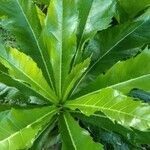Sparingly branched treelet or tree up to 8 m tall. Leafy twigs 7-12 mm thick, gla-brous, hollow; periderm ± flaking off. Leaves spirally arranged, ± tufted; lamina sagittate-pandurate, 25-80 by 7-25 cm, symmetric, coriaceous, apex acuminate, base cordate, margin coarsely dentate to sublobate; both surfaces glabrous, smooth; cystoliths on both sides; lateral veins 20-24 pairs, most of them furcate far from the margin, the lower ones departing the midrib at right angles, tertiary venation (sub)scalariform; waxy glands in the axils of the basal lateral veins and smaller ones in furcations of the lateral veins; petiole 0.5-3 cm long, glabrous, the epidermis flaking off; stipules 2-5 cm long, (usually) glabrous, (sub)persistent. Figs axillary, in pairs, with a peduncle up to 0.6 cm long or (sub)sessile; basal bracts 3, ± scattered 3-5 mm long, coriaceous, glabrous, persistent; receptacle ellipsoid, 3-4 by 2-3 cm when dry, glabrous, usually ± conspicuously pustulate-lenticellate, sometimes with a single or several lateral bracts, at maturity yellowish, apex slightly protracted, ostiole 5-7 mm diam., surrounded by erect apical bracts; internal bristles absent.
More
A fig. It is a small palm like tree. It grows 6 m tall. It spreads 3 m wide. It has a few branches of a few stems from the base. The leaves are alternate and crowded towards the ends of branches. The leaves are smooth and shiny on the upper surface while paler beneath. They can be 1 m long. The flowers parts are fused toward the base and occur one or two together. They are a dull red or purplish when mature. The plant is an unusual and ornamental fig. The fruit are oblong and ridged. They are greenish-purple with white spots. It is pollinated by the fig wasp, Ceratosolen bakeri.

